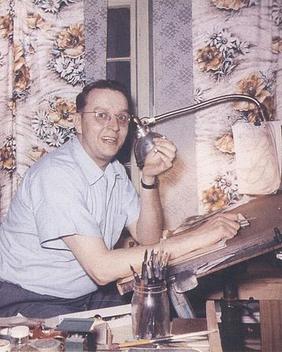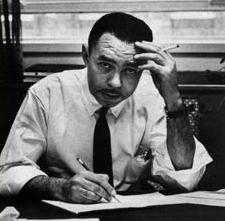Related Research Articles

A comic strip is a sequence of cartoons, arranged in interrelated panels to display brief humor or form a narrative, often serialized, with text in balloons and captions. Traditionally, throughout the 20th and into the 21st century, these have been published in newspapers and magazines, with daily horizontal strips printed in black-and-white in newspapers, while Sunday papers offered longer sequences in special color comics sections. With the advent of the internet, online comic strips began to appear as webcomics.

The National Cartoonists Society (NCS) is an organization of professional cartoonists in the United States. It presents the National Cartoonists Society Awards. The Society was born in 1946 when groups of cartoonists got together to entertain the troops. They enjoyed each other's company and decided to meet on a regular basis.

Jack Ralph Cole was an American cartoonist best known for creating the comedic superhero Plastic Man, and his cartoons for Playboy magazine.

King Features Syndicate, Inc. is an American content distribution and animation studio, consumer product licensing and print syndication company owned by Hearst Communications that distributes about 150 comic strips, newspaper columns, editorial cartoons, puzzles, and games to nearly 5,000 newspapers worldwide. King Features Syndicate also produces intellectual properties, develops new content and franchises, like The Cuphead Show!, which it produced with Netflix, and licenses its classic characters and properties. King Features Syndicate is a unit of Hearst Holdings, Inc., which combines the Hearst Corporation's cable-network partnerships, television programming and distribution activities, and syndication companies. King Features' affiliate syndicates are North America Syndicate and Cowles Syndicate.

Henry is a comic strip created in 1932 by Carl Thomas Anderson. The title character is a young bald boy who is mute. Except a few early episodes, the comic strip character communicates largely but not entirely through pantomime, a situation which changed when Henry moved into comic books. Henry has spoken in at least one Betty Boop cartoon from 1935. In the feature, Betty Boop has a pet shop and Henry speaks to a dog in the window.

Laugh Parade was a group of weekly gag cartoons written by Bunny Hoest and drawn by John Reiner. It ran in Parade, a Sunday newspaper magazine supplement.

Grin and Bear It is a former daily comic panel created by George Lichtenstein under the pen name George Lichty. Lichty created Grin and Bear it in 1932 and it ran 83 years until 2015, making it the 10th-longest-running comic strip in American history. Frequent subjects included computers, excessive capitalism and Soviet bureaucracy. Situations in his cartoons often took place in the offices of commissars, or the showrooms of "Belchfire" dealers with enormous cars in the background. His series "Is Party Line, Comrade!" skewered Soviet bureaucrats, always wearing a five-pointed star medal with the label "Hero".

William Pierce Hoest was an American cartoonist best known as the creator of the gag panel series, The Lockhorns, distributed by King Features Syndicate to 500 newspapers in 23 countries, and Laugh Parade for Parade. He also created other syndicated strips and panels for King Features.

Ted Key was an American cartoonist and writer. He is best known as the creator of the cartoon panel Hazel, which was later the basis for a television series of the same name, and also the creator of the Peabody's Improbable History animated segments.

Henry Boltinoff was an American cartoonist who worked for both comic strips and comic books. He was a prolific cartoonist and drew many of the humor and filler strips that appeared in National Periodical comics from the 1940s through the 1960s.

Don Orehek was an American freelance cartoonist who contributed gag cartoons to a wide variety of newspapers, magazines and books. On more obscure publications, he used several pseudonyms, including Sam de Sade, Di Benvenuto and Kobasa.

Irving David Breger was an American cartoonist who created the syndicated Mister Breger (1945–1970), a gag panel series and Sunday comic strip known earlier as Private Breger and G.I. Joe. The series led to widespread usage of the term "G.I. Joe" during World War II and later. Dave Breger was his signature and the byline on his books. During World War II, his cartoons were signed Sgt. Dave Breger.
1000 Jokes was a humor magazine launched by Dell Publishing in 1937. With a later title change to 1000 Jokes Magazine, it was published quarterly over three decades. During the 1950s, it was edited by Bill Yates with associate editor John Norment.

This Funny World was a gag cartoon panel syndicated to newspapers by the McNaught Syndicate from March 6, 1944, to 1985.
Bob Weber, Sr., was an American cartoonist, best known for his Moose and Molly comic strip, distributed by King Features Syndicate.
Quincy is an American syndicated newspaper comic strip published from July 13, 1970 to October 4, 1986, created and produced by cartoonist Ted Shearer. The series, about an African-American boy being raised by his grandmother in Harlem, was one of the earliest mainstream comic strips to star an African American in the lead role, following Dateline: Danger! (1968-1974) and Luther (1969-1986). Another predecessor, Wee Pals, features an African-American among an ensemble cast of different races and ethnicities.

Thaddeus Shearer was an African-American advertising art director and cartoonist whose 1970–1986 Quincy was one of the earliest mainstream comic strips to star an African American in the lead role.
The New York World was one of the first newspapers to publish comic strips, starting around 1890, and contributed greatly to the development of the American comic strip. Notable strips that originated with the World included Richard F. Outcault's Hogan's Alley, Rudolph Dirks' The Captain and the Kids, Denys Wortman's Everyday Movies, Fritzi Ritz, Gus Mager's Hawkshaw the Detective, Victor Forsythe's Joe Jinks, and Robert Moore Brinkerhoff's Little Mary Mixup.
Hilary B. Price is an American cartoonist. She is known for creating the comic strip Rhymes with Orange, which is published digitally on her website and in over one hundred newspapers across the United States. At the age of 25 she became the youngest cartoonist to ever be nationally syndicated. She won the Silver Reuben for "Best Newspaper Panel Cartoon" from the National Cartoonists Society four times, in 2007 and 2009, 2012 and 2014.
References
- ↑ Holtz, Allan. "Obscurity of the Day: Laff-a-Day," Stripper's Guide (October 10, 2012).
- ↑ "Eli Stein Cartoons". Archived from the original on 2007-10-18. Retrieved 2012-01-08.
- ↑ King Features Syndicate
- ↑ Packratter [ permanent dead link ]